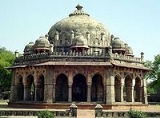
Isa Khan Niyazi
Encyclopedia

Afghanistan
Afghanistan , officially the Islamic Republic of Afghanistan, is a landlocked country located in the centre of Asia, forming South Asia, Central Asia and the Middle East. With a population of about 29 million, it has an area of , making it the 42nd most populous and 41st largest nation in the world...
noble in the court of Sher Shah Suri
Sher Shah Suri
Sher Shah Suri , birth name Farid Khan, also known as Sher Khan , was the founder of the short-lived Sur Empire in northern India, with its capital at Delhi, before its demise in the hands of the resurgent Mughal Empire...
and his son Islam Shah Suri
Islam Shah Suri
Islam Shah Suri was the second ruler of the Sur dynasty which ruled part of India in the mid-16th century. His original name was Jalal Khan and he was the second son of Sher Shah Suri. On his father's death, an emergency meeting of nobles chose him to be successor instead of his elder brother Adil...
, of the Sur dynasty
Sur Dynasty
The Suri Empire was established by a Muslim dynasty of Afghan origin who ruled a vast territory in the Indian subcontinent between 1540 to 1557, with Delhi serving as its capital...
, who fought the Mughal Empire
Mughal Empire
The Mughal Empire , or Mogul Empire in traditional English usage, was an imperial power from the Indian Subcontinent. The Mughal emperors were descendants of the Timurids...
.
Isa Khan's tomb complex

Tomb of Isa Khan
Isa Khan's tomb built during his lifetime ca 1547-48 AD, is situated near the Mughal Emperor HumayunHumayun
Nasir ud-din Muhammad Humayun was the second Mughal Emperor who ruled present day Afghanistan, Pakistan, and parts of northern India from 1530–1540 and again from 1555–1556. Like his father, Babur, he lost his kingdom early, but with Persian aid, he eventually regained an even larger one...
's Tomb complex
Humayun's Tomb
Humayun's tomb is the tomb of the Mughal Emperor Humayun. The tomb was commissioned by Humayun's wife Hamida Banu Begum in 1562 AD, and designed by Mirak Mirza Ghiyath, a Persian architect...
in Delhi
Delhi
Delhi , officially National Capital Territory of Delhi , is the largest metropolis by area and the second-largest by population in India, next to Mumbai. It is the eighth largest metropolis in the world by population with 16,753,265 inhabitants in the Territory at the 2011 Census...
which was built later, between 1562-1571 AD. Built within an enclosed octagonal garden, it bears a striking resemblance to other tombs of Sur dynasty monuments in the Lodhi Gardens
Lodhi Gardens
Lodi Gardens is a park in Delhi, India. Spread over , it contains, Mohammed Shah's Tomb, Sikander Lodi's Tomb, Sheesh Gumbad and Bara Gumbad, architectural works of the 15th century Sayyid and Lodis, a Pashtun dynasty which ruled much of Northern India during the 16th century, and the site is now...
. This octagonal tomb has distinct ornamentation in the form of canopies, glazed tiles and lattice screens and a deep veranda, around it supported by pillars. It stand south of the Bu Halima garden just as visitors enter the complex. An inscription on a red sandstone slab indicated that the tomb is of Masnad Ali Isa Khan, son of Niyaz Aghwan, the Chief chamberlain
Chamberlain (office)
A chamberlain is an officer in charge of managing a household. In many countries there are ceremonial posts associated with the household of the sovereign....
, and was built during the reign of Islam Shah Suri
Islam Shah Suri
Islam Shah Suri was the second ruler of the Sur dynasty which ruled part of India in the mid-16th century. His original name was Jalal Khan and he was the second son of Sher Shah Suri. On his father's death, an emergency meeting of nobles chose him to be successor instead of his elder brother Adil...
, son of Sher Shah, in 1547-48 A.D.
On 5 August 2011 the restoration work on this tomb in New Delhi led to the discovery of the India's oldest sunken garden. Isa Khan’s garden tomb in the enclosed area of Humayun’s Tomb World Heritage Site in the Capital of India can now be considered the earliest example of a sunken garden in India – attached to a tomb – a concept later developed at Akbar’s Tomb and at the Taj Mahal.
Mosque of Isa Khan
At the edge of the complex, across from the tomb, lies a mosque with noticeable mehrabs. It is known as Isa Khan's Mosque, and was built along with the tomb. Many of the architectural details present in these structures can be seen further evolved in the main Humayun's tomb, though on a much grander scale, such as the tomb being placed in a walled garden enclosure.External links
- The Mughal Empire from In Our Time (BBC Radio 4)In Our Time (BBC Radio 4)In Our Time is a live BBC radio discussion series exploring the history of ideas, presented by Melvyn Bragg since 15 October 1998.. It is one of BBC radio's most successful discussion programmes, acknowledged to have "transformed the landscape for serious ideas at peak listening time"...
- Mughal Empire
- The Great Mughals
- Gardens of the Mughal Empire
- A 3D photo-montage (PhotoSynth) of the Tomb

